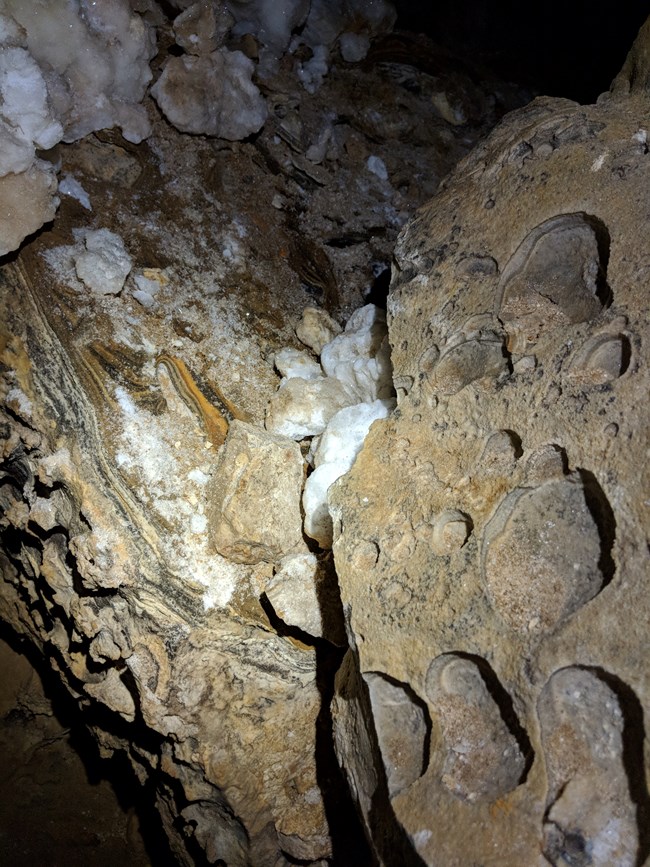Part of a series of articles titled Inside Earth – NPS Cave & Karst News – Fall 2020.
Previous: High Adventure in Carlsbad Cavern
Article

NPS photo by Dan Pawlak.
Submitted by Dan Pawlak, Park Guide
For Inside Earth Newsletter, Fall 2020
Until 2019, a section of Carlsbad Caverns National Park had been abandoned for 43 years. It was not rediscovered until Derek Bristol and Aria Mildice, survey trip leaders, and their teams explored a section of cave now called Lil’ Lechuguilla. This section of cave has proven to be quite beautiful, delicate, and full of surprises.
Lil’ Lechuguilla was first discovered in 1976 and is off the Guadalupe Room, the second largest chamber in Carlsbad Cavern. The survey stations of the first explorers can be found in the cave. However, the maps and the data from the survey cannot. According to the park’s resources department, the survey of Lil’ Lechuguilla was so poor the data was erased years ago. This action opened the door for Derek and Aria to remap and explore a section of cave that was lost to the park. Since only one other team had been in this area 43 years ago the area is practically pristine and the maps to be made are brand new.
Derek’s team explored this section of cave earlier in 2019. Aria’s four person team, The Guad Squad, started on November 7th where Derek’s team stopped. After scrambling down and through a large breakdown slope explorers reached an area of solid limestone covered in delicate gypsum. The gypsum is so prolific it appears as a coating of snow on every surface of the cave creating an underground winter wonderland. One wrong step and time would have melted off the cave walls. This room in which Aria’s survey began holds a very delicate and rare type of cave formation, a gypsum chandelier. There are only two other caves in the Guadalupe Mountains, Lechuguilla Cave and Cottonwood Cave, to have gypsum chandeliers. While the chandelier was impressive there were more surprises ahead.

NPS photo by Dan Pawlak.
Slowly moving through fragile areas and taking precise measurements the team pressed on. The establishment of a new survey station meant the park was regaining what it once lost. At the same time the cave was gaining a voice for the stories it has to tell. After survey station 26 was established a team member moved forward and disappeared from sight. All that was heard was, “This room is huge!” The team had made their way into a chamber with ceilings at least 43 ft (13 m) high. The chamber was tall and long with many potential leads. Still covering the walls was the delicate gypsum but there was something new covering the floor. The floor of the chamber was made up of calcite rafts piled 20 ft (6 m) high. Calcite rafts can only form on the surface of a calm pool or body of water. The rafts then sink when they are hit by a droplet of water. Seeing rafts this tall and prolific meant this chamber was once flooded for a very long time. Beauty continued even after the mountain of calcite rafts.

NPS photo by Dan Pawlak.

NPS photo by Dan Pawlak.
As the survey continued through this room a large pit, gypsum stalagmites, and selenite needles were revealed. The large pit, now called the BFP (Big Freaking Pit), is at the end of the long axis of the room and is over 30 ft (9 m) deep. Another team will be returning in the future to explore the depths of this pit. Away from the pit a gypsum stalagmite was discovered. Gypsum stalagmites are rare because they do not form like regular stalagmites. Instead of water dripping and placing calcite on the floor the dripping water erodes layers of gypsum already on the ground which sometimes leaves behind conical mounds as stalagmites.

NPS photo by Dan Pawlak
These formations are rarity because gypsum is highly soluble and many times the evidence of the gypsum is erased by the dripping water. Another form of gypsum was also found in a very fragile form, selenite blades. Selenite blades form underwater when containing a high concentration of selenite in the pool water. The crystals then form on the edges and lining of the pool creating very delicate and transparent blades a couple of inches long. Seeing bladed selenite supports the idea the chamber was filled with water and then drained leaving behind the rafts and crystals. All of these features combined made for a room containing deep unknown darkness countered with thousands of crystals reflecting light mesmerizing those inside the chamber.
Eventually Aria’s team made their way through the room and found a passage with an almost nonexistent floor. The passage terminated horizontally but the openings in the floor have the potential to connect to the bottom of the BFP. If this pitted floor connects, a hand line will be needed to reach the bottom of the BFP instead of rappelling down. Only the people who surveyed Lil’ Lechuguilla 43 years earlier know what lies at the bottom of the pit. However, their data is gone so the credit of discovery now goes to the explorers of today who push the boundaries Carlsbad Cavern like the teams of Derek and Aria.

NPS photo by Dan Pawlak.
Part of a series of articles titled Inside Earth – NPS Cave & Karst News – Fall 2020.
Previous: High Adventure in Carlsbad Cavern
Last updated: October 6, 2020